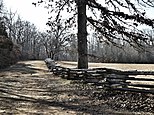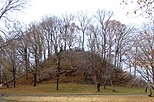West Tennessee | |
|---|---|
|
Clockwise, from top left: The Memphis Pyramid, Graceland, Beale Street, Pinson Mounds, Shiloh National Military Park, Reelfoot Lake | |
| Nickname(s): West TN, West Tenn. | |
 The counties of Tennessee highlighted in red that are designated part of West Tennessee. | |
| Country | |
| State | |
| Largest city | Memphis |
| Area | |
| • Land | 27,600 km2 (10,650 sq mi) |
| Population (2020) | 1,557,649 |
| • Density | 56.47/km2 (146.26/sq mi) |
| Demonym | West Tennessean |
West Tennessee is one of the three Grand Divisions of Tennessee that roughly comprises the western quarter of the state.[1] The region includes 21 counties between the Tennessee and Mississippi rivers, delineated by state law.[2] Its geography consists primarily of flat lands with rich soil and vast floodplain areas of the Mississippi River.[3][1] Of the three regions, West Tennessee is the most sharply defined geographically, and is the lowest-lying.[4] It is both the least populous and smallest, in land area, of the three Grand Divisions. Its largest city is Memphis, the state's second most populous city.
West Tennessee was originally inhabited by the Chickasaw, and was the last of the three Grand Divisions to be settled by Europeans. The region officially became part of the United States with the Jackson Purchase in 1818, 22 years after Tennessee's statehood. As part of the Mississippi River basin, West Tennessee enjoys rich soil that led to large-scale cotton farming during the antebellum period that was heavily dependent on slave labor.[4] As a result, it forms the northwestern tip of the Black Belt.[5]
- ^ a b "Tennessee | Capital, Map, Population, History, & Facts". Encyclopædia Britannica. Archived from the original on 2019-12-15. Retrieved 2019-10-15.
- ^ "Tennessee Blue Book 2015-2016" (PDF). Nashville: Tennessee Secretary of State. 2015. p. 639. Archived from the original (PDF) on 2018-09-10. Retrieved June 5, 2021.
- ^ "West Region". www.tn.gov. Archived from the original on 2019-10-29. Retrieved 2019-10-15.
- ^ a b "Tennessee Culture - Tennessee History - Grand Divisions - THS". Tennessee Historical Society. 2017-03-13. Archived from the original on 2022-04-07. Retrieved 2019-10-15.
- ^ Billy Corriher (2021-12-16). "Fighting gerrymandering in the South's Black Belt". Facing South. Archived from the original on 2022-06-11. Retrieved 2022-07-03.





